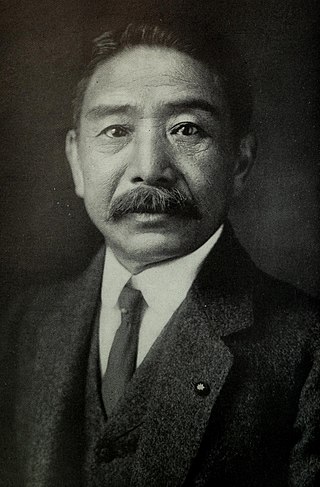Top Qs
Timeline
Chat
Perspective
Chinda Sutemi
Japanese diplomat (1857–1929) From Wikipedia, the free encyclopedia
Remove ads
Count Chinda Sutemi (珍田 捨巳; 19 January 1857 – 16 January 1929) was a Japanese diplomat and courtier who served as Grand Chamberlain to the Emperor from 1927 to 1929.
During his diplomatic career, he served as ambassador to Germany, the United States and Great Britain. He was a plentipotentiary at the 1919 Paris Peace Conference.
Remove ads
Diplomatic career
Summarize
Perspective
He was born 19 January 1857, in Hirosaki, Aomori.
In 1877 he went to study at DePauw University in the United States.[1] He got his B.A. in 1881, and M.A. in 1884. In 1882 he married, and had one son.[2]
From 1890 to 1894, Chinda served as Japanese Consul in San Francisco, California. In 1897 Chinda was appointed first Japanese Minister Plenipotentiary to Brazil, following the establishment of diplomatic relations between the two states in 1895.[3] He served as Japanese Ambassador to Germany from 1908 to 1911, to the United States from 1912 to 1916.
Ambassador Chinda Sutemi and his wife Japanese Viscountess Chinda Iwa were two of the diplomats involved with the Japanese gifting of the cherry blossom trees to Washington, D.C. in 1912.[4] As official representatives of Japan, Ambassador Sutemi Chinda and his wife, Japanese Viscountess Iwa Chinda, joined with President Taft's wife, First Lady Helen Herron Taft on March 27, 1912. Each woman planted one of the recently arrived Yoshino cherry trees in the nation's capital onto the northern bank of the then empty landscape around the Washington, D.C. Tidal Basin, about 125 feet south of what is now Independence Avenue, SW. At the conclusion of the ceremony, the first lady presented a bouquet of "American Beauty" roses to Viscountess Chinda. Washington's renowned National Cherry Blossom Festival grew from this simple ceremony, witnessed by just a few persons. These two original trees still stand several hundred yards west of the John Paul Jones Memorial, located at the terminus of 17th Street, SW. Situated near the bases of the trees is a large bronze plaque which commemorates the occasion. This gift was officially seen as coming from the capital city of Japan, Tokyo, to the capital city of the United States, Washington, D.C. The illustrated biography The Art of Peace presents Prince Iyesato Tokugawa and his Japanese allies' pivotal involvement in bringing about the gifting of these cherry blossom trees as a means of promoting international goodwill.[5]
In 1915, while Count Chinda Sutemi was the Japanese Ambassador to the United States he greeted the visiting Japanese statesmen Baron Eiichi Shibusawa when Shibusawa visited New York City. The 1915 photo illustration to the right presents Chinda at the event honoring the visit of Baron Shibusawa which was attended by two former U.S. Presidents Theodore Roosevelt and William Howard Taft.[6][7]
Chinda served as ambassador to the United Kingdom from 1916 to 1920, during which time he also took part in the Japanese delegation to the Paris Peace Conference, 1919.[8] He was part of the Commission on Colonial Mandates, which drafted a mandates system that would subject of approval by the League of Nations members.[9]
In January 1919, Sutemi wrote to Chaim Weizmann that, "the Japanese government gladly takes note of the Zionism aspiration to extend in Palestine a national home for the Jewish people and they look forward with a sympathetic interest to the realization of such desire upon the basis proposed."[10]
In 1919, he was a plenipotentiary ambassador for Japan in its delegation to the Paris Peace Conference where he signed the Treaty of Versailles and advocated for racial equality.[11]: 262–63
In 1921, Chinda was selected by Imperial Household Minister Makino Nobuaki to serve as Grand Master of Crown Prince Hirohito's Household. When the Crown Prince acceded to the throne in 1926, Chinda was appointed Grand Master of the Empress's Household, before being promoted to Grand Chamberlain to the Emperor in March 1927. He was one of the Emperor's closest advisors during his early reign. Chinda died on 16 January 1929.[12]
He was also a Methodist minister.
Remove ads
Honours
From the Japanese Wikipedia article
Titles
- Baron (21 September 1907)
- Viscount (24 August 1911)
- Count (7 September 1920)
Decorations (Japanese)
- Grand Cordon of the Order of the Sacred Treasure (1 April 1906; Third Class: 5 March 1902; Fourth Class: 28 June 1898; Fifth Class: 31 October 1895)
- Grand Cordon of the Order of the Rising Sun (14 September 1907)
- Grand Cordon of the Order of the Rising Sun with Paulownia Flowers (7 September 1920)
Court order of precedence
- Seventh rank (27 November 1886)
- Sixth rank (21 December 1891)
- Senior sixth rank (20 September 1895)
- Senior fifth rank (20 August 1897)
- Fourth rank (31 January 1901)
- Senior fourth rank (20 March 1906)
- Third rank (30 April 1909)
- Senior third rank (11 May 1914)
- Second rank (30 May 1921)
- Senior second rank (1 June 1928)
- First rank (16 January 1929)
Remove ads
See also
References
Further reading
Wikiwand - on
Seamless Wikipedia browsing. On steroids.
Remove ads

